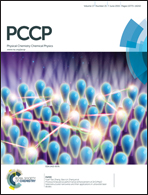Phospholipid-based self-assembled mesophase systems for light-activated drug delivery†
Abstract
The manipulation of the structure of phospholipid-based mesophases to induce a slow to fast drug release profile has potential for use in therapeutic situations where continuous absorption of drug is not desirable and reduce the frequency of injection for short acting or rapidly cleared drugs in treatments for diseases such as macular degeneration. This study had two aims; firstly to confirm the phase behaviour of 20 mol% cholesterol in 1-palmitoyl-2-oleoyl-sn-glycero-3-phosphoethanolamine (POPE), which was previously reported to transition from lamellar (slow release) to bicontinuous cubic (fast release) phase with increasing temperature. Contrary to the literature, no bicontinuous cubic phase was observed but a transition to the inverse hexagonal phase occurred at all POPE : cholesterol ratios investigated. The second aim was to render these mesophases responsive to near-infrared laser (NIR) irradiation by incorporation of gold nanorods (GNR) incorporated into the POPE system to induce photothermal heating. The inclusion of 3 nM GNR in POPE systems induced reversible disruption of lipid packing equivalent to increasing the temperature to 55 °C when irradiated for 30 s. This study confirmed that although the previously published phase behavior was not correct, GNR and NIR can be used to manipulate the self-assembled mesophases in phospholipid-based systems and highlights the potential for a phospholipid-based light-activated drug delivery system.


 Please wait while we load your content...
Please wait while we load your content...